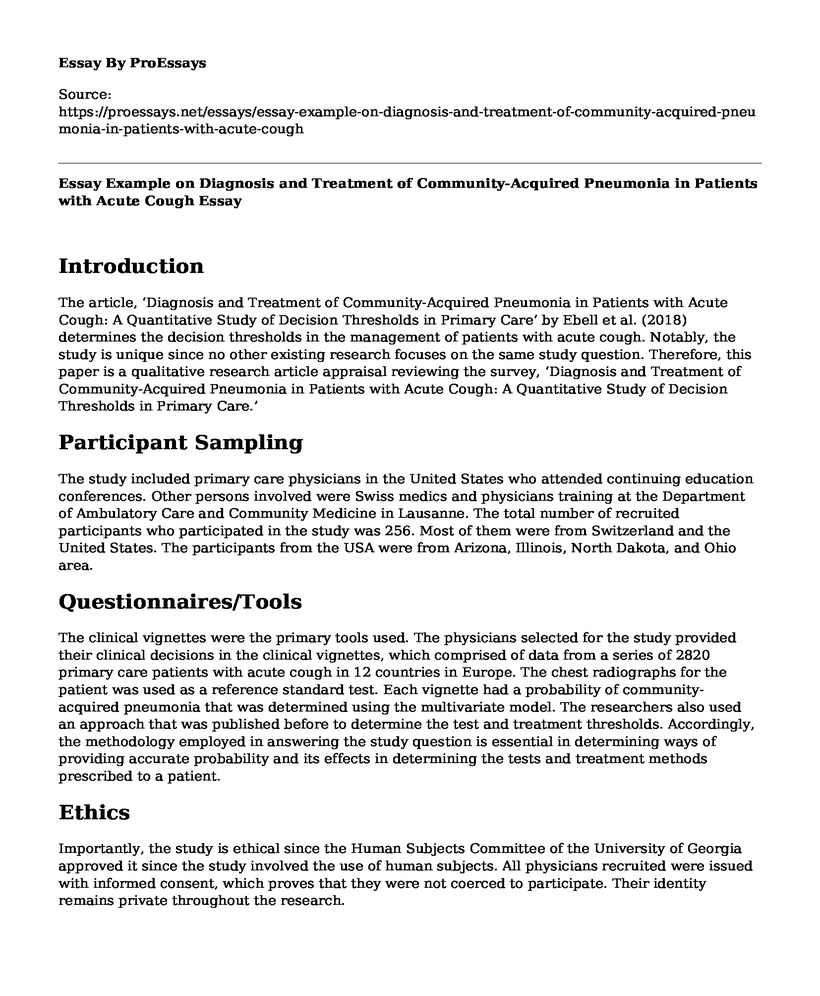Introduction
The article, ‘Diagnosis and Treatment of Community-Acquired Pneumonia in Patients with Acute Cough: A Quantitative Study of Decision Thresholds in Primary Care’ by Ebell et al. (2018) determines the decision thresholds in the management of patients with acute cough. Notably, the study is unique since no other existing research focuses on the same study question. Therefore, this paper is a qualitative research article appraisal reviewing the survey, ‘Diagnosis and Treatment of Community-Acquired Pneumonia in Patients with Acute Cough: A Quantitative Study of Decision Thresholds in Primary Care.’
Participant Sampling
The study included primary care physicians in the United States who attended continuing education conferences. Other persons involved were Swiss medics and physicians training at the Department of Ambulatory Care and Community Medicine in Lausanne. The total number of recruited participants who participated in the study was 256. Most of them were from Switzerland and the United States. The participants from the USA were from Arizona, Illinois, North Dakota, and Ohio area.
Questionnaires/Tools
The clinical vignettes were the primary tools used. The physicians selected for the study provided their clinical decisions in the clinical vignettes, which comprised of data from a series of 2820 primary care patients with acute cough in 12 countries in Europe. The chest radiographs for the patient was used as a reference standard test. Each vignette had a probability of community-acquired pneumonia that was determined using the multivariate model. The researchers also used an approach that was published before to determine the test and treatment thresholds. Accordingly, the methodology employed in answering the study question is essential in determining ways of providing accurate probability and its effects in determining the tests and treatment methods prescribed to a patient.
Ethics
Importantly, the study is ethical since the Human Subjects Committee of the University of Georgia approved it since the study involved the use of human subjects. All physicians recruited were issued with informed consent, which proves that they were not coerced to participate. Their identity remains private throughout the research.
Analysis of Findings
The results were that the primary care physicians in the United States and Switzerland overestimated the CAP probability after they were issued with a clinical scenario. With this in mind, the test and treatment estimated by the physicians were higher than the corresponding thresholds. The analysis and treatment methods were aligned to the probabilities that the physicians had made initially. The treatment prescribed by the Swiss physicians was higher than that of the US physicians’ possibility to avoid the issuance and prescription of unnecessary antibiotics. A higher treatment threshold was observed if radiographs were available and for physicians outside the primary care category. The findings show that the study has fulfilled its aims and objectives since it has proven how probability influences treatment and testing thresholds among physicians.
Limitations
The researchers outline some of the limitations and strengths of their study. An advantage that was observed was the use of realistic scenarios, which made the study valid and reliable. However, the use of vignettes could be the source of social desirability bias, which would have been avoided by directly observing a physician’s behavior. The data used to generate the scenarios was from Europe and may have underestimated the probability of CAP in the United States. The limitations indicated may have affected the validity of the data to a small extent.
Discussion Section
In the section, the authors analyze the results and explain them in depth. The section allows a reader to comprehend the findings generated in the research. For instance, a reader is likely to understand why the test and treatment thresholds of the physicians are higher than those represented in the model. Also, they explain why some physicians had a slight change of thought after issuance with the actual probability.
Summary
Importantly, this study is essential in the field of research and medicine. A future study could explore the decision thresholds of a patient that is likely to differ from that of clinicians. The understanding of a patient threshold is an essential factor to consider in a situation where doctors want to indulge in shared decision-making. In practice, the results could help in allowing the acceptability of clinical decision rules and improving their efficiency in selection and treatment.
References
Ebell, M. H., Locatelli, I., Mueller, Y., Senn, N., & Morgan, K. (2018). Diagnosis and treatment of community-acquired pneumonia in patients with acute cough: A quantitative study of decision thresholds in primary care. British Journal of General Practice, 68(676), e765–e774. https://doi.org/10.3399/bjgp18x699545
Cite this page
Essay Example on Diagnosis and Treatment of Community-Acquired Pneumonia in Patients with Acute Cough. (2023, Aug 27). Retrieved from https://proessays.net/essays/essay-example-on-diagnosis-and-treatment-of-community-acquired-pneumonia-in-patients-with-acute-cough
If you are the original author of this essay and no longer wish to have it published on the ProEssays website, please click below to request its removal:
- Paper Example on Disorders of Ventilation and Gas Exchange
- Essay Sample on Nursing, Health and Wellbeing
- The Case of the Article "Trends in Opioid Analgesic Abuse and Mortality in the United States"
- Why the Health System Should Embrace and Foster Workforce Diversity - Essay Sample
- Water Pollution and Human Health - Article Analysis Essay
- Abortion: A Controversial Issue Open to Debate and Discussion - Essay Sample
- Essay on Non-Professionals: How to Deal With Social Determinants of Health







